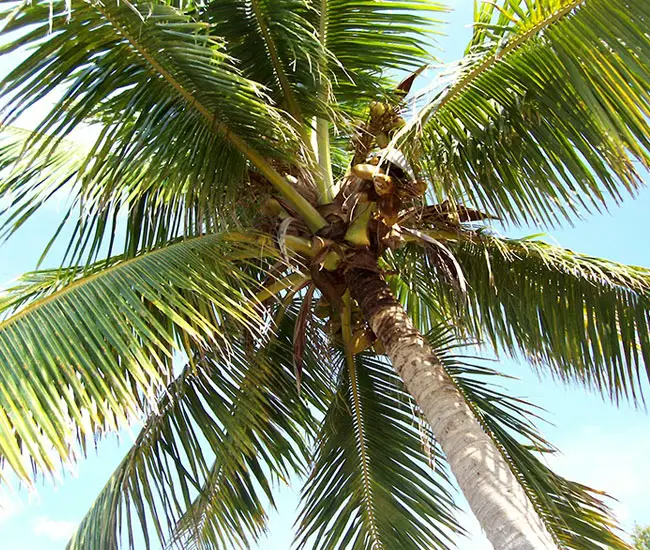
Caring for palm trees can be fun and rewarding if you know what you are doing. Generally, a well established palm is low to no maintenance as long as you provide it with enough water and regular fertilization.
Healthy palms naturally resist insect pests and diseases so you rarely have to worry about that. In most cases, insects are more of an annoyance than a real problem.
Occasional trimming of dead leaves to keep their beautiful appearance and some cold protection in case of a cold snap might be needed for some species.
Choosing The Right Palm Tree
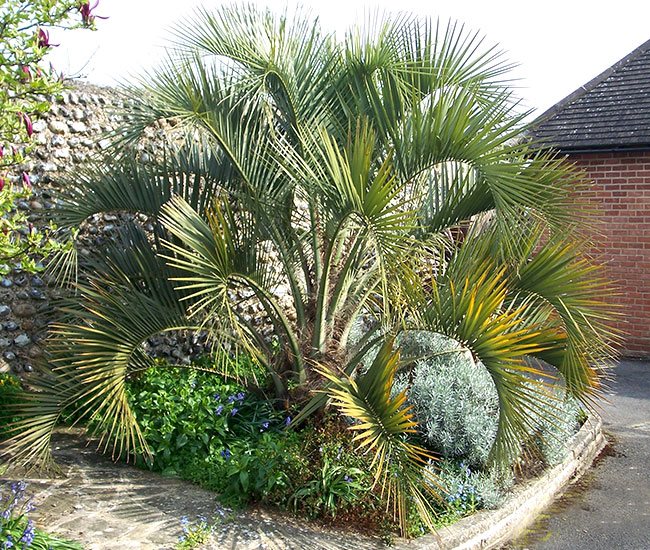
Palm tree care starts with choosing the right tree for your garden. I can’t stress enough how important this step is. If you don’t pick the right palm, you will end up with a big problem.
Think about appearance of the palm, the purpose, and the location in your yard. All these things are equally important. You probably already have some ideas of where you would like to plant your palm.
Are you going to create an attractive focal point, or some kind of a border line throughout the front yard? Or just use it for some shade around the pool area? Whatever your goals are, each requires a different type of palm.
Many trees don’t want full sun while others demand it. That being said, think about amount of sunlight your palm will be getting. You don’t want to plant for example Triangle Palm in a shade because it requires full sun.
Another factor is the size. How much space do you have? Planting a Canary Island Palm in a small yard would be a mistake. Yes, it is small right now, but it can grow up to 60 feet tall with leaves spreading 20 feet wide. Can you imagine this huge tree in a small garden?
So be careful, this small cute palm tree that you are buying can grow pretty fast and in a few years you might end up with a big headache. If you have a smaller garden, make sure to get small palm trees that will stay small.
On the other hand, tall fast-growing trees are perfect for creating more shade around the pool or to form a borderline.
Best pH Levels For Palms
Soil pH levels range from acidic ones, that can be found in volcanic areas, to alkaline limestone soils in South Florida. Thankfully, many palms can adapt to wide range of pH and do well in either alkaline or acidic soil.
However, there are some species that do better in one or the other. As a matter of fact, if you plant an acid-loving palm in alkaline soil, it will not flourish. Here is an example of palms for acidic and alkaline soils:
| Palms For Acidic Soil | Palms For Alkaline Soil |
| Foxtail Palm | Bailey Palm |
| Joey Palm | Blue Latan Palm |
| King Palm | Bottle Palm |
| Lipstick Palm | Needle Palm |
| Queen Palm | Date Palm |
In general, sand-based soil, like sandy loam, that has a pH of 6.3 to 6.8 seems to work for most palm species, especially the tropical ones. You can test your pH levels with very inexpensive soil acidity test strips or more advanced soil pH meter.
If you soil is too acidic (pH under 6.3 for palm trees), use some dolomite limestone to increase the pH levels. If you soil is too alkaline, don’t use dolomite, but add sulfur instead. Keep in mind, the more organic soil amendments you use, the higher the soil acidity will get.
Should You Amend Soil Before Planting Palm Trees?
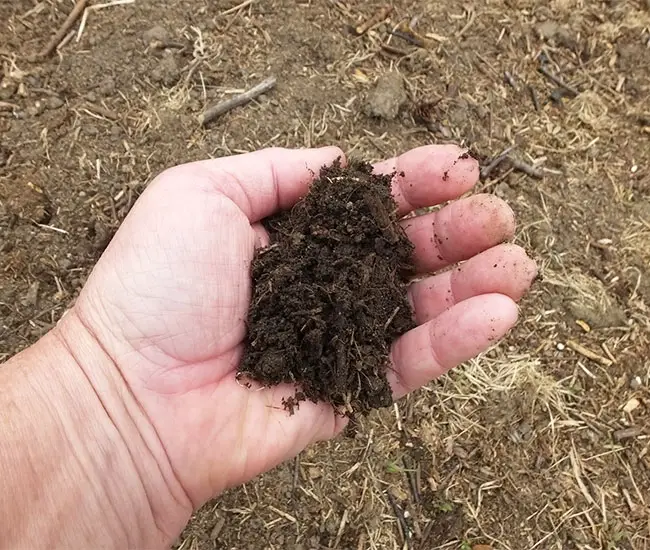
To amend, or not to amend, that is the question… There are a lot of discussions on soil amendments for outdoor palms. Some gardeners saying it has little to no effect while others think it helps the root development.
There has been even a few studies done by several universities including University of California, and Washington State University, that all came to the conclusion that there is no significant benefit of soil amendment in the long run.
While I agree, that over time the plant will need to get used to the native soil, I also think that the first few weeks of establishment are crucial in determining whether the tree lives or dies.
I personally like to amend the soil because it decreases the initial shock from transplanting and also makes it easier for the palm to grow new roots while it’s adjusting to the new location.
Why Good Soil Drainage is Important
Before planting the palm, test the drainage. Regardless of whether a palm prefers wet or dry soil conditions it has to drain well.
You can test the soil by digging a hole and filling it with water. 15 inches deep will be enough. Then, fill it again. If the water drains within 1-2 hours you have a great drainage. If it takes 12 hours, it’s ok. If the water is still there after a day or two, you have a problem.
Bad drainage should be fixed or you will end up with a swimming pool at the bottom of your tree. Constantly soggy conditions might lead to root rot and eventually death of the plant.
Don’t worry. Here are a few ways you can improve it:
- Place some rocks to the bottom of the hole. This will help with the drainage making sure your palm roots are not sitting in standing water. Of course, with a lot of rains it won’t help for long.
- Drill holes at the bottom and the sides of the hole to loosen up the clay soil and to improve the drainage.
- In the worst case, install a pipe that will take the water away from the plant.
- Use sand in the soil mix when planting the palm.
Best Soil For Outdoor Palm Trees
The best soil for palm trees is a loose, porous soil mixture, that is light and well-draining. Sand-based soil, like sandy loam, is a good example of the soil type that palm trees like. Generally, sandy loam soil consist of 60% sand, 10% clay and 30% silt particles.
Unlike hard clay soils, it’s loose enough for the roots to spread and contains enough clay to provide structure and fertility. You can also add some organic matter such as compost or combination of peat moss, leaf mold, and shredded bark.
Trust me, it will be much easier to care for a palm tree that grows in the right soil. Here are soil mixes I would use depending on the soil type:
- Clay soil. If you have clay soil, loosen the soil as much as you can by breaking large clods. Then add one part of organic matter and one part of coarse sand to three parts of the native soil.
- Sandy soil. For sandy soil, use one part of organic matter to three parts of your native soil.
- Lava rock soil. For lava rock, a finer grade of lava cinders is a good backfill. You could add one part of organic matter to three parts of your native soil.
- Limestone rock soil. For limestone rock, you could use #12 grit coarse sand. Add one part of the sand to three parts of your native soil.
You can use any organic materials available in your local area which includes: cedar bark, aged leaf matter, bark mulch, ground bark, sawdust, aged lawn cuttings, sawdust and etc. I like to use Sphagnum Peat Moss to make sure my soil has excellent drainage.
How to Water Outdoor Palm Trees
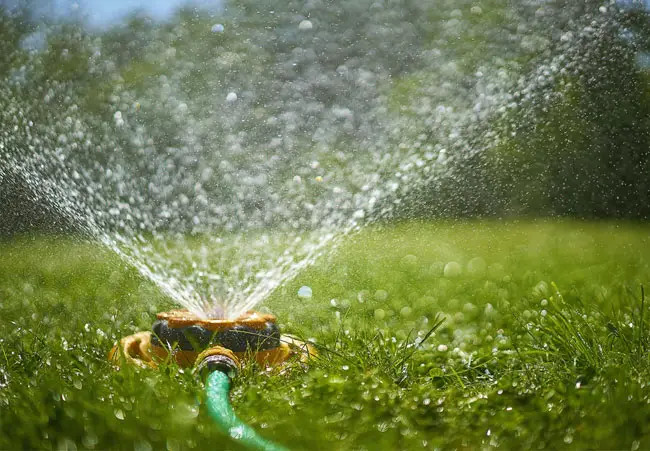
Watering schedule of a newly planted palm differs from the palm that has been established. Palms lose a lot or even all of their roots during transplanting which often leads to water stress. The remaining roots have a hard time providing palm with enough water.
That is why you should water a newly planted palm more often right after planting. Water every day for the first week, every other day for the second week, and 2-3 times a week after that. I like to deep water (slow dripping) my trees, that way the soil has more time to absorb all of the water.
The amount of water should be around 10-20% of the container size for that palm. If it’s a 10 gallon container, then use 1-2 gallons of water. I know some sites recommend using 10 gallons of water for 10 gallon palm, but that’s just a water waste! Believe me, 1 gallon will be plenty!
Application of mulch and soil barrier will help to retain the water. During summer months when it’s hotter, water your palm more.
During winter months when it’s cooler and your palm is not actively growing, water less (like once a week). Use common sense and adjust your watering depending on the season.
The best time to water you palms is in the morning or late in the evening when it’s not too hot and sun is not too bright. Because drops of water have magnifying effect, they can fry the leaves during sunny day.
If you can afford it, get a sprinkler system with a timer. That way, you won’t have to remember to turn the water off. It will save you time and you water bill will be much lower.
How and When to Fertilize Palm Trees
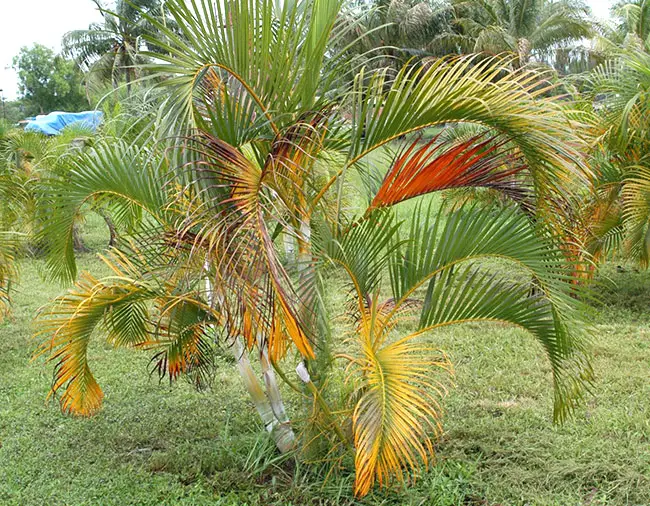
In general, palm trees should be only fertilized during growing season which starts from end of March and lasts till the end of October. However, the frequency of fertilization greatly depends on amount of rains in your area and your soil type.
Heavy rains and sandy soil escalates nutrient loss from the soil. You’ll need to fertilize more often, like 3-4 times a year, if you live in rainy state like Florida and about 2-3 times a year, if you live in California.
If you live in a warm climate where temperatures don’t drop very low, you can apply fertilizer four times a year. If you live in the area where the temperatures drop below freezing, stop fertilizing a few months before the first cold snap.
Don’t listen to the gardeners who are saying that fertilizing during winter months will help the palm to grow better in the Spring. It really doesn’t. It only creates more stress for the plant by promoting growth at the wrong time of the year.
Newly planted palms should NOT be fertilized right away. Wait for the plant to develop new growth before applying fertilizer. Two to four weeks should be enough for the palm to acclimate to your garden. After that, apply good quality fertilizer with all the nutrients.
Best Fertilizer for Palm Trees
For most palms a complete fertilizer with the same amounts of Nitrogen (N) and Potassium (K) is ideal. Look for a fertilizer that has three numbers on the front of the package like: 10-5-10 or 12-4-12. It’s the NPK (Nitrogen, Phosphate, and Potassium) ratio. The higher the number, the stronger the fertilizer is.
Aside from the main NPK elements, a good quality fertilizer will have at least 6 other microelements like Magnesium, Manganese, Sulphur, Boron, Copper, Iron, and Zinc.
Don’t buy cheap fertilizer trying to save money, because it means less quality for your palm. Just like with cheap vitamins, cheap fertilizer will not provide your palm with all the needed nutrients.
Also, use a fertilizer with a slow-release formula. If the nutrients are released too quickly, the roots can absorb only a portion of them while the rest of the fertilizer is wasted. In addition, frequent rains can wash the fertilizer away before the roots had a chance to soak it up.
If you are looking for an easy to use fertilizer that has a slow-release formula with all the necessary nutrients, try Jobe’s Palm Fertilizer. It dissolves slowly and feeds your tree for up to 6 months. Here is Jobe’s Outdoor Palm Fertilizer and Jobe’s Indoor Palm Fertilizer.
Benefit of Mulching Palm Trees
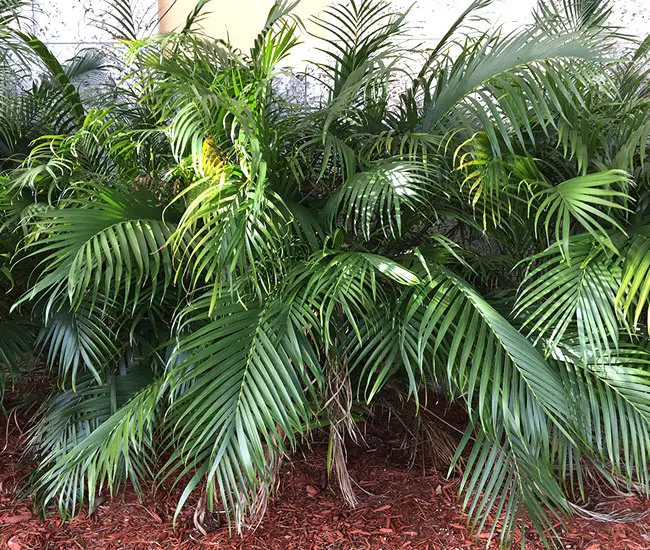
Use mulch around the base of the palm to help the soil retain moister and to keep the weeds out. It works much better than the lawn which can use up all the nutrients and water intended for the palm.
With lawn too close to the palm, there is also a chance of trunk damage during the grass trimming.
Avoid using string trimmer too close to the palm because the string can cut the trunk permanently scaring it. Unlike woody trees, palm is unable to heal itself when its trunk is injured.
In addition, lawn fertilizer might have a high concentration of nitrate that can lead to palm burn or injury if applied near the palm roots.
Apply about 2-4 inches of mulch making the layer thicker over the root zone and thinner near the trunk. Place it about 1 foot away from the trunk since excess mulch piled against the trunk can cause trunk rot and fungal disease and prevents water from penetrating into the root zone.
How to Trim Palm Trees
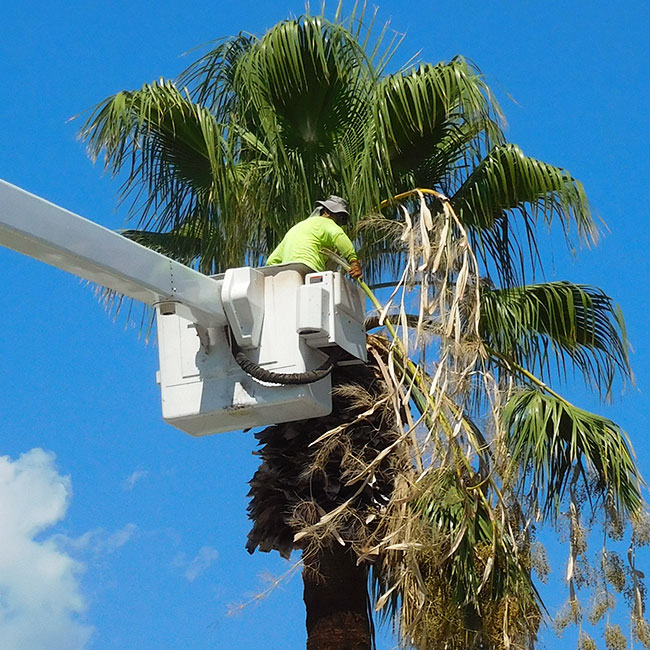
Trimming palms is much simpler than trimming other broadleaf trees. On most palms, all you have to remove are old fruit stems and dead fronds. There are even some ‘self-cleaning’ palms that drop their old leaves once they turn brown and dry.
Keep in mind, trimming old dying fronds will NOT improve the growth of the new fronds. Why? Because, unlike broadleaf trees, palms use nutrition from lower dying leaves to produce new growth.
Therefore, if you trim them, it will create more stress for the plant and will slow down the formation of the new beautiful leaves. I know, all these brown leaves don’t look that good, but don’t cut them until they are dry. Otherwise you would be hurting your tree instead of helping it.
While there are a few different palm tree cuts, I wouldn’t recommend pruning fronds below horizontal line. Especially, avoid so called ‘hurricane cut’. Many services, with nothing else to do, offer it before hurricane comes.
It’s a drastic cut that only leaves a few fronds at the very top. In reality, it only creates more stress for the tree and does NOT help against hurricane.
When removing the leaves, cut as close to the trunk as possible without injuring the trunk. The remaining leaf base will eventually fall off on its own or you can pull it off when it is dry and loose.
How to Protect Palm Trees from Cold
Most palms like warm weather and get cold damage if the temperature drops below 45F. However, there are some species that can survive cold winters with temperatures as low as 10-15F.
If you live in the tropical climate, don’t worry about it, anything will grow. But, if you live in a colder state, you need to spend some time on research, because not every palm can survive in cold temperatures.
Protecting your trees from cold during winter months is absolutely crucial. Even if you live in a warm tropical climate you can get a nasty cold snap that can kill your palms in matter of a few hours.
You can’t even imagine how many emails I get about cold damaged palms during winter. And a lot of times there is nothing that can be done to save those palms. So, if you know that cold is coming your way be prepared.
It’s much easier to protect your palm before the temperatures drop. Once the bud, where the leaves are growing from, of the palm is damaged, the palm will die. It can’t regenerate the tissue of the bud. That is why it’s important to do everything you can to protect it.
There are many cold protection techniques you can use. You can start by applying 4-6 inches of mulch around palm root zone to protect the roots.
Next, you can use a blanket during cold night hours and wrap it around the trunk. Also, small heater and light bulbs will keep the area around the tree warm.
Why Palm Tree Leaves Are Turning Brown
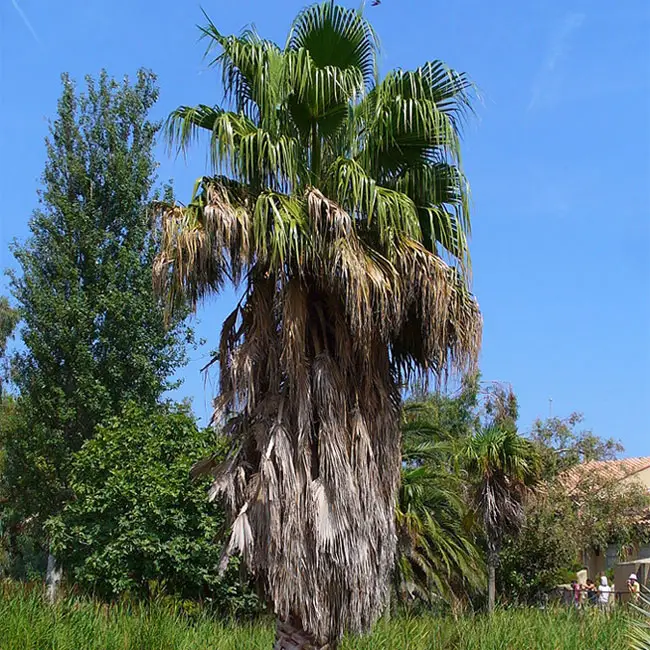
A noticeable yellowing and browning of the leaves could be a sign that your palm is in trouble or could be just a part of natural process. Here is a few ways you can tell what’s wrong:
- Brown tips and leaf edges may be a response to low humidity or drought. It can also be a sign of underwatering. Check the soil to see if it’s moist and adjust your watering schedule. Light foliage misting in the evening hours can be refreshing for the fronds and increase the humidity levels around the plant.
- Browning of an older lower branch or two while the plant still produces new leaves is normal. Let the leaves turn brown and dry before trimming them off.
- Too much fertilizer can also cause tips to brown. Use slow-release fertilizer during growing season.
- Too much water or poor drainage can causes browning and drooping of the leaves that fall before drying. Check the moister level of the soil and adjust the watering schedule. The amount of water should be no more than 10-20% of the container size for that palm.
- Not enough water can cause the entire palm to turn brown and dry. Palms need watering when the surface of the soil is dry. Deep water the palm until the soil is moist.
- Cold damage can cause browning or even blackening of the leaves. If the new growth looks nice and green, the plant will recover. If the new growth emerges deformed, black or brown, the palm might not survive.
Conclusion
I hope this article helps homeowners new to palm trees. Remember, caring for palms is not that hard. Most of the time you just need to water and fertilize them. But, occasional cold protection during cold weather can make a huge difference.
The main secret to successful palm tree care is in creating an environment as close to it’s natural habitat as possible. Find out its place of origin and see what type of climate it is used to. You will know what soil type, humidity levels, amount of rain, and temperatures the palm can tolerate.
Related articles:
- Top 10 Palm Tree Transplanting Mistakes
- Transplanting Palm Tree from a Container into the Ground
- Expert Advice: How To Water Palm Trees The Right Way
- Palm Tree Cold Protection
- How to Save Cold Damaged Palm Tree
\

I had 18 fox palm trees transplanted. It’s about 6 months now. They keep getting new growth from the top, but the branches are shedding quite a bit. Is this normal?
Hi, Can over pruning, especially pruning of the green leafs result in poor health and possible death of the tree. I have also heard the over pruning can cause the tree to fall over in bad weather.
Thanks
We have a palm tree or more bush type that appears to be rotting down the middle and the palm leaves are dying off. Can you help please?
Fruitful Information. I just bought palms. I will use this knowledge will help me.
I inherited three tall Mexican palms. The former owners planted dense foliage around the base of each tree. I have two questions. I have tried to fertilize with spikes under the drip line which is generally in the foliage. The trees look good but not great. I figure the foliage is absorbing most of the water and fertilizer. The second question is that if I dig up or thin the foliage will the digging harm the root system of the palms.
Should I use Quick Start on newly planted palms to enhance the root establishment
my queen palm tree die after grow up to 15 feet
Already second One any idea what what is it causing
I though I knew a lot about palm trees, but I am always reminded that there is more to learn everyday! Thanks for this great write up.